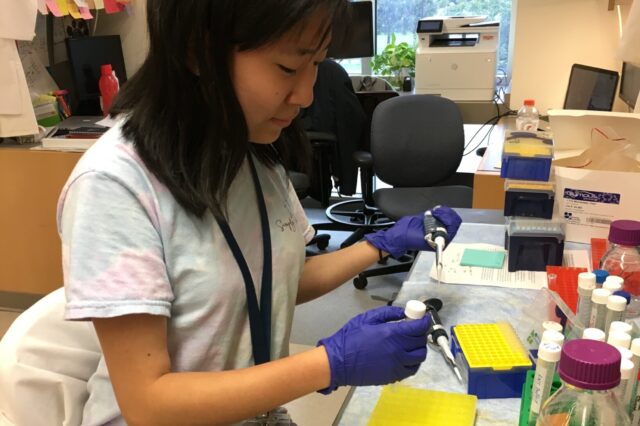UF summer program has been giving high school students a boost toward their dreams for 60 years

Even as a young child, Truman Roland absolutely loved science.
“He was in the first grade and he wrote and illustrated a book about cells,” said Krista Roland, Truman’s mother. “His teacher let him sit in the front of the class and he would show them his drawings of the cell wall and mitochondria.”
Krista and her husband, Jacob Roland, said they were frustrated by the lack of opportunities locally available for their son to explore his passion. Thanks to a program offered by the University of Florida, the 17-year-old rising senior at Citrus High School has been getting the experience he craves by working in a lab alongside UF scientists this summer.
Now celebrating its 60th year, the University of Florida Center for Precollegiate Education and Training, or CPET, introduces high school students to advanced STEM research. Over 5,000 students have benefited from the center’s Student Science Training Program, or SSTP, which pairs about 90 students each year with a laboratory at the university to conduct high-level scientific research for seven weeks.
Mary Jo Koroly, Ph.D., a researcher in the UF College of Medicine’s department of biochemistry and molecular biology, is the director of CPET. For the past 23 years, she has been in charge of the SSTP program and its initiative to give the next generation of bright minds a head start on their dreams.
“I think there are tremendous benefits to having opportunities like this,” Koroly said. “It’s not about recruiting kids to the university, it’s about recruiting kids into science and engineering.”
During her tenure as head of the program, Koroly has sought to put an emphasis on making the academically talented pool of students accepted each year as intellectually and socially diverse as possible.
She says the program takes about 30 students who are from low-income families or underserved communities. While most of the students come from Florida, about a dozen each year are selected from out of state.
The application process involves writing two essays explaining the student’s specific scientific interest and where they see themselves in the future both academically and professionally. Academic records and endorsements from two teachers or mentors in STEM fields are also required.
After committing to attend, students and their families are responsible for the program’s $4,800 cost, which does not cover meals. Scholarships are available, however, to cover all or part for the costs.
The Smallwood Foundation, a family-owned philanthropic organization based in Texas, supports at least five students each year and has sent more than 75 students to the program in the past 10 years. Grants from the National Science Foundation and the National Institutes of Health are also available.
Some scholarships are available specifically to attendees from a specific county. Sometimes these scholarships are based on a specific foundation like the Heart of Volusia for students from Volusia County, others may be from donors.
Roland, for example, was able to attend thanks to an anonymous donor who paid a large portion of his tuition through a Citrus County foundation.
“It really gave me the opportunity to do the work I’ve really wanted to do for a long time,” he said. Before the summer of 2018, the most experience he had working in science came from school projects.
For him, this was a huge step forward. Over the course of the program, Roland and his 88 classmates attended early morning lectures before working eight hours in a lab alongside tenured research faculty, Ph.D. candidates and graduate students. By the end of SSTP, each high schooler had given two oral presentations, created and presented a poster display of their work, compiled the fruits of their research into a 20-page scientific paper and earned up to six college credits.
Karen Copeland, a music-loving teen who attends a prestigious high school for the arts, worked at the Evelyn F. and William L. McKnight Brain Institute of the University of Florida, where she assisted Walter O’Dell, Ph.D., an assistant professor in the UF College of Medicine’s department of radiation oncology , in his research into the vascular structure of the lung and radiation-induced diseases.
Priya Patel investigated neurodegenerative diseases in the neuroscience gene therapy lab under the tutelage of postdoctoral associate Kim Hawkins, Ph.D., and Coy Heldermon, M.D., Ph.D., an assistant professor in the UF College of Medicine’s division of hematology and oncology.
Jacob Rosenfeld worked with a 3D scaffold design with the hope of creating techniques that can one day treat Type 1 diabetes. Asked to describe the experience of working in the lab, Rosenfeld called it “fantastic!”
In years past, participants in the summer program went on to college and continued the same research they worked on as teens. Several students during the program’s closing ceremony this year expressed a desire to do the same. Like Roland, they all had wanted to be involved in high-level science for as long as they could remember.
Thanks to SSTP and the support from the program’s supporters, Roland and his classmates were able to fulfill long-held dreams to be at the leading edge of scientific inquiry.
“You can see him glow and shine,” Jacob Rolandsaid. “It’s just wonderful as a parent when your child can finally do the things that they want to do.”
For more information, contact Rossana Passaniti at passar@shands.ufl.edu or 352-273-8569.